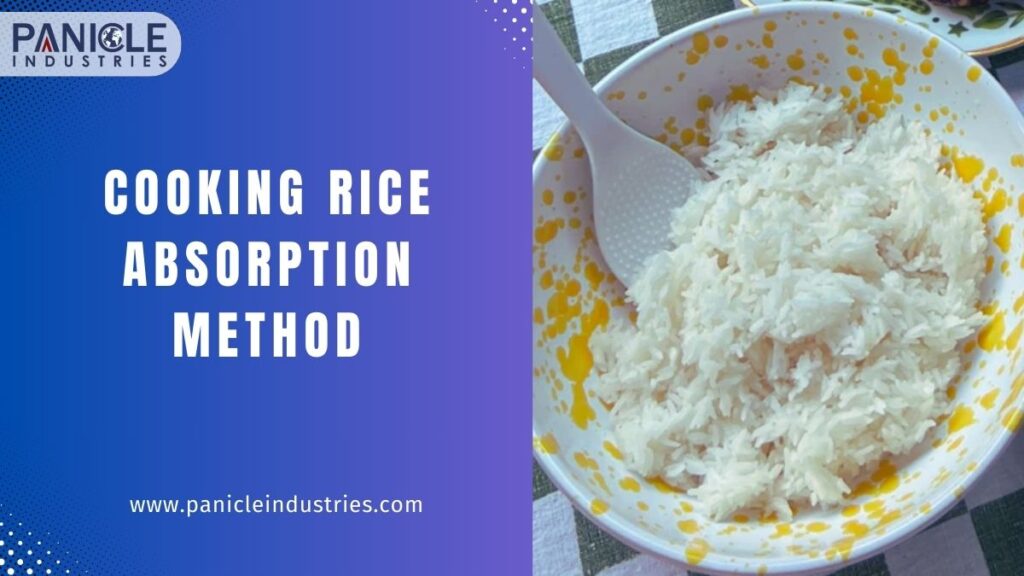If you’re someone who loves rice but finds it tricky to cook it just right, this blog is for you. One of the easiest and most effective ways to cook rice is by using the cooking rice absorption method. This method is loved by many home cooks because it’s simple, needs no draining, and gives you fluffy rice every time. If you’ve ever asked yourself why your rice turns out too mushy or too hard, the absorption method might just be the solution.
In this blog, we will talk about cooking rice absorption method is, how it works, and why it’s so popular. Let’s learn how you can cook rice like a pro with very little effort.
What Is the Absorption Method?
The absorption method is a way of cooking rice where all the water added to the rice is fully absorbed during cooking. This means there is no water left to drain at the end. It’s a gentle, steam-based method that lets the rice cook slowly and evenly.
Unlike boiling rice in lots of water and draining the extra, the absorption method uses a fixed ratio of rice to water. The pot is usually covered with a lid, and the rice is left to simmer until all the water is soaked up. This method locks in the flavor and nutrients of the rice.
Also read: Should Rice Be Washed Before Cooking
Why Use the Absorption Method?
There are many reasons why the cooking rice absorption method is a favorite in homes and even in professional kitchens:
- No Waste: Since all the water is absorbed, there is no draining, which means no nutrients are lost.
- Better Flavor: The rice keeps its natural taste because nothing is poured out.
- Simple Process: Once you know the water-to-rice ratio, it’s a set-it-and-forget-it method.
- Even Cooking: Each grain is cooked gently and evenly, giving fluffy and separate rice.
- Energy Saving: It uses low heat and minimal attention once the lid is on.
Step-by-Step: Cooking Rice Absorption Method
Let’s go through how to actually use the cooking rice absorption method at home.
1. Measure the Rice
Decide how much rice you want to cook. A common serving is about 1/2 to 1 cup of uncooked rice per person.
2. Rinse the Rice
It’s a good idea to rinse your rice under cold water to remove extra starch. This helps prevent stickiness. Just rinse until the water runs clear.
3. Add Water
Use the correct water-to-rice ratio. For white rice, the usual ratio is:
- 1 cup of rice to 2 cups of water.
For brown rice or other types, you might need a bit more water:
- 1 cup brown rice to 2.5 cups of water.
You can also add a pinch of salt or a little butter/oil for flavor.
4. Bring to a Boil
Place the pot on the stove and bring the water to a boil over medium-high heat. Don’t walk away just yet—this step is quick.
5. Reduce Heat and Cover
Once the water starts boiling, lower the heat to the lowest setting and cover the pot with a tight-fitting lid.
6. Simmer and Wait
Let the rice cook without lifting the lid. For white rice, this takes about 15–20 minutes. Brown rice might need 35–45 minutes.
7. Rest the Rice
Once all the water is gone, turn off the heat but leave the pot covered for 5–10 minutes. This resting time lets the rice finish steaming and makes it even fluffier.
8. Fluff and Serve
Use a fork to fluff the rice gently before serving. It should be light, separate, and perfectly cooked.
Common Mistakes to Avoid
Even though the absorption method is simple, there are a few mistakes that can spoil the rice.
1. Using the Wrong Ratio
Too much water makes the rice mushy; too little makes it dry. Always measure.
2. Lifting the Lid
Resist the urge to peek! Let the rice cook undisturbed to keep in the steam.
3. High Heat
Cooking rice too fast on high heat will burn the bottom and leave the top raw. Always simmer on low.
4. Not Letting It Rest
Skipping the rest time at the end can make the rice clump together.
Tips for Best Results
- Use a heavy-bottomed pot to avoid burning the rice.
- If your lid doesn’t fit tight, you can place a clean kitchen towel under the lid to seal in steam.
- Add spices or herbs to the water for extra flavor.
- Try using vegetable or chicken broth instead of water for tastier rice.
Types of Rice That Work Well with the Absorption Method
Most rice types can be cooked using this method. Here are some examples:
- Basmati Rice – Long, fragrant grains perfect for Indian dishes.
- Jasmine Rice – Soft and slightly sticky, great for Thai meals.
- Brown Rice – Nutty flavor, needs more water and time.
- Parboiled Rice – Holds shape well and doesn’t get mushy.
- White Long Grain Rice – Most common and very easy to cook.
Why People Prefer This Method
Many people love the cooking rice absorption method because it’s clean, easy, and doesn’t waste anything. It’s ideal for those who want soft, fluffy rice with less effort. It also saves time since you don’t need to babysit the pot once it’s covered. Whether you’re a beginner or an experienced cook, this method makes rice cooking feel less stressful and more enjoyable.
Bonus Tip for Rice Lovers
If you’re someone who eats rice regularly, using the absorption method can become your go-to style. You can even batch cook and store the rice in the fridge for 3–4 days. Just reheat with a sprinkle of water, and it tastes fresh again.
Also, if you’re looking for quality rice for your kitchen, we sell premium basmati and non-basmati rice for home and export. Try our rice with the absorption method—you’ll love the results!
Conclusion
To sum up, the cooking rice absorption method is one of the easiest and most effective ways to make delicious, fluffy rice. It doesn’t need draining, keeps the flavor in, and is simple enough for anyone to try. By using the right water ratio, simmering on low heat, and letting the rice rest after cooking, you can get perfect results every time.
Whether you enjoy rice with curries, vegetables, or just a little butter, this method makes it shine. Give it a try at home and enjoy better rice with less hassle. Once you master it, you may never go back to any other way of cooking rice again.


